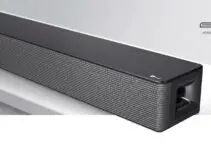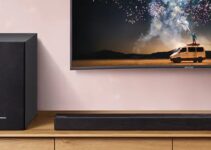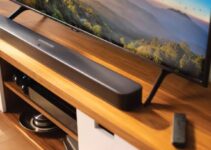In recent times, soundbar systems have risen in popularity as a decent choice for listening to good audio quality in the home, without necessarily committing to the bulkiness that comes with a full surround sound system. Samsung, a global leader in consumer electronics, offers a diverse range of soundbars that cater to varying needs and preferences.
One crucial aspect that consumers often consider when getting home appliances is power consumption, as energy efficiency not only impacts the environment but also affects electricity bills.
In this article, we delve into the intricacies of Samsung soundbar power consumption, analyzing factors that influence it and providing insights into making informed choices.

Samsung Soundbar Power Ratings
The power ratings of Samsung soundbars vary depending on the model and features. Below are some of the best-selling soundbars by Samsung and their power ratings.
| Model | Power Ratings (watts) |
| Samsung HW-Q950A | 520 |
| Samsung HW-Q800A | 430 |
| Samsung HW-Q600A | 320 |
| Samsung HW-Q55T | 280 |
| Samsung HW-Q45OT | 240 |
From the table, you can see that the Samsung HW-Q950A is the most powerful soundbar in the list, with a power rating of 520 watts. This soundbar is designed for large rooms and offers immersive surround sound.
The Samsung HW-Q450T is the least powerful soundbar in the list, with a power rating of 240 watts. This soundbar is a good option for smaller rooms or for people who are looking for a more affordable soundbar.
While that’s the case, it’s important to emphasize that these power ratings are assumed for maximum power consumption. The actual power consumption will vary depending on the volume level and the features that are being used.
For example, the power consumption will be higher when the soundbar is set to a high-volume level or when it is using features such as Dolby Atmos or DTS:X. At any rate, Samsung soundbars are generally built to be energy efficient, coming with certifications like ENERGY STAR.
Understanding Power Consumption
Power consumption is simply the amount of electrical energy used by a device over a specific period – typically measured in Kilowatt-hours or watt-second for household electronics.
Transposing this meaning directly to Samsung soundbars, we can understand that it’s the power consumed by our soundbar throughout the time it’s plugged into a power source; whether it’s fully operational or on standby. The rate at which power is consumed by the soundbar always determines its environmental impact and economic efficiency.
Factors Influencing Samsung Soundbar Power Consumption
Even though Samsung declares the power rating of its soundbars, the wattage published alongside the specs of the device isn’t enough to fully grasp its rate of power consumption; only serves to know the power ratings.
It doesn’t quite qualify for the time element, knowing how long it has to be used to consume a specific amount of power. To fully grasp the power consumption of these soundbars it’s important to discuss individual factors responsible for power consumption.
Audio Output and Features
The power consumption of a soundbar is largely dependent on the level of sound it can produce, and the kind of features that’s integrated with. Meanwhile, even if there’s a situation when a Samsung Soundbar is rated with relatively high wattage, it doesn’t exactly equate to the device’s power consumption when it’s not being used to full capacity.
Thus, we can say that soundbars equipped with advanced features like built-in amplifiers, wireless connectivity, and virtual surround sound processing may not necessarily consume more power when compared to a soundbar with lower specs if the former is being operated well-below capacity, and the latter is playing at maximum capacity.
While that’s the case, it’s important we bring to your attention that the concept of “Features” here encompasses the entire functionality of the soundbar – which ranges from sound modes and settings to connectivity options.
The more these functions/features are built into a soundbar, the more it’s likely to be a significant power consumer, although this isn’t set in stone as power consumed can vary based on actual use.
Standby Power Consumption
Also known as vampire power, this refers to the energy a device consumes when it’s turned off but still plugged in. There are some Samsung soundbar models that have features like quick start-up which when running on standby mode, can consume small amounts of power constantly. Let’s look at a quick comparison of Samsung soundbars and their standby power ratings.
| Model | Standby Power Consumption (watts) |
| Samsung HW-Q950A | 0.5 |
| Samsung HW-Q800A | 0.5 |
| Samsung HW-Q600A | 0.5 |
| Samsung HW-Q55T | 0.4 |
| Samsung HW-Q45OT | 0.3 |
From the table above, you can see that the standby power consumption ratings of Samsung soundbars are quite low. However, this doesn’t directly translate to actual standby power consumption, it still depends on the kinds of features you use that work in standby mode.
The standby power consumption may be higher if the soundbar is connected to a network or if it is set to automatically power on when it detects a signal from a TV.
Soundbar Size and Design
Although this is somewhat of a no-brainer, it’s important it’s included in this article. The physical dimensions and design of a soundbar can give you a hint of its power consumption capabilities.
A company like Samsung, they’re less likely to create a soundbar with a bloated structure, having more space than is required to effectively function. As such, the general rule of thumb is that larger soundbars may require more energy to operate effectively while the slimmer one will use less power.









